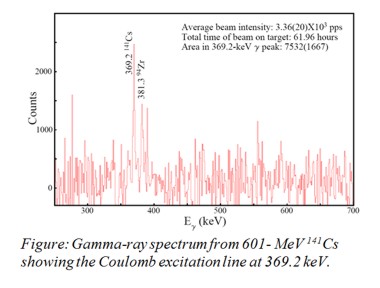Physics Division Research Highlights
First Coulomb excitation measurement using CARIBU beam
Octupole collectivity is expected to occur in the neutron-rich Ba-La region, near N=90 and Z=56, owing to the interaction between d5/2 and h11/2 protons as well as between i13/2 and f7/2 neutrons. Even though evidence for such a phenomenon has been inferred from prompt g-ray studies [1] of 252Cf fission fragments, there remain unresolved issues regarding the absolute strength of this collectivity and its evolution with proton and neutron number. Coulomb excitation of these rare isotopes will help address these questions. At ATLAS, the Californium Rare Isotope Breeder Upgrade (CARIBU) facility is now producing re-accelerated beams of these neutron-rich nuclei with sufficient intensities to perform Coulomb excitation experiments.
 The first Coulomb excitation measurement was carried out at Gammasphere using a 141Cs beam to achieve two experimental goals. The first was to benchmark the effects of beam intensity, stable-beam contamination, and gamma-ray backgrounds from the decay of radioactive beams. A better understanding of these effects will assist in the planning of future experiments. With a thick (50 mg/cm2) 208Pb target and a 141Cs beam energy of 850 MeV and 4300 particles/second for a 14.5 hour run, it was demonstrated that the gamma background from 141Cs decay can be subtracted cleanly using the RF-timing technique. The Coulomb excitation gamma ray from 141Cs is clearly visible: see figure. The second goal was to measure the B(E2) transition probability of the 11/2+ state in 141Cs. This is a transitional nucleus located in the region where quadrupole and octupole collectivities are developing. For this purpose, the beam energy was lowered to 601 MeV, the so-called “safe” energy. The measurement lasted for ~62 hours with a beam intensity of ~3360 particles/second. The B(E2) value for the 11/2+ level was determined to be 20(5) W.u. Compared to the neighboring nuclei, this value is smaller than that measured for the 2+ level in 142Ba (32(1) W.u.), but similar to the value for the 2+ state in 140Xe (25.6(8) W.u.), suggesting that 140Xe is the core of 141Cs with a single proton located outside it and that the addition of one proton in 142Ba results in a large quadrupole deformation.
The first Coulomb excitation measurement was carried out at Gammasphere using a 141Cs beam to achieve two experimental goals. The first was to benchmark the effects of beam intensity, stable-beam contamination, and gamma-ray backgrounds from the decay of radioactive beams. A better understanding of these effects will assist in the planning of future experiments. With a thick (50 mg/cm2) 208Pb target and a 141Cs beam energy of 850 MeV and 4300 particles/second for a 14.5 hour run, it was demonstrated that the gamma background from 141Cs decay can be subtracted cleanly using the RF-timing technique. The Coulomb excitation gamma ray from 141Cs is clearly visible: see figure. The second goal was to measure the B(E2) transition probability of the 11/2+ state in 141Cs. This is a transitional nucleus located in the region where quadrupole and octupole collectivities are developing. For this purpose, the beam energy was lowered to 601 MeV, the so-called “safe” energy. The measurement lasted for ~62 hours with a beam intensity of ~3360 particles/second. The B(E2) value for the 11/2+ level was determined to be 20(5) W.u. Compared to the neighboring nuclei, this value is smaller than that measured for the 2+ level in 142Ba (32(1) W.u.), but similar to the value for the 2+ state in 140Xe (25.6(8) W.u.), suggesting that 140Xe is the core of 141Cs with a single proton located outside it and that the addition of one proton in 142Ba results in a large quadrupole deformation.
This first successful Coulomb excitation experiment with a reaccelerated CARIBU beam yielded interesting first physics results. It also indicated that the intensities of a large number of radioactive beams already available from CARIBU are sufficient to perform similar experiments.
References
[1] W. Urban et al., Nuc. Phys. A 613, 107 (1997).
![[Argonne Logo]](/images/argonne_header_logo.jpg)
![[DOE Logo]](/images/header_doe.gif)